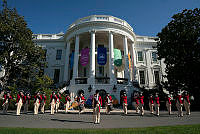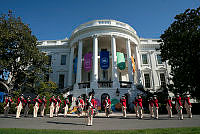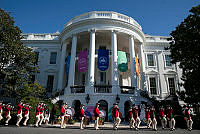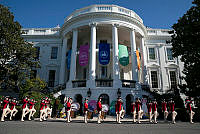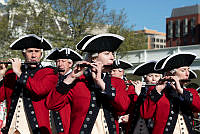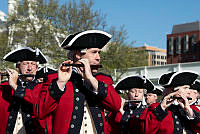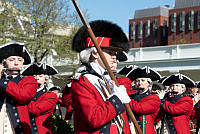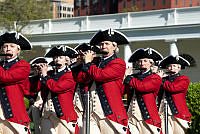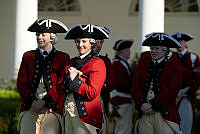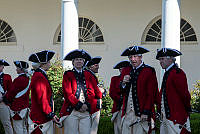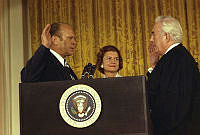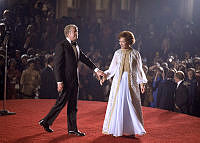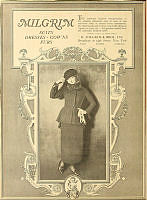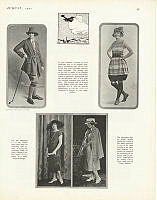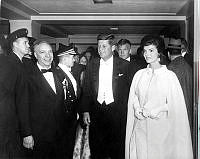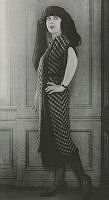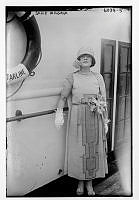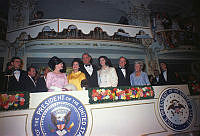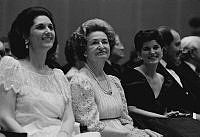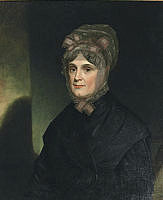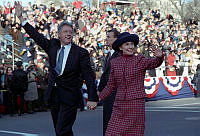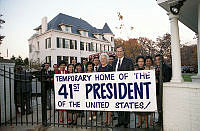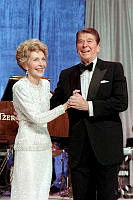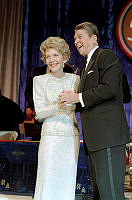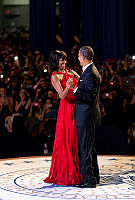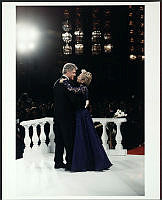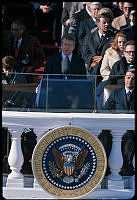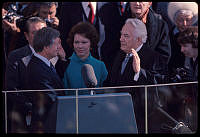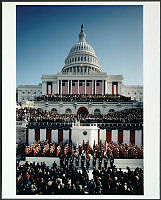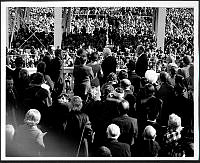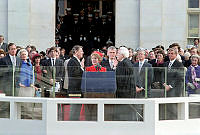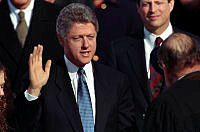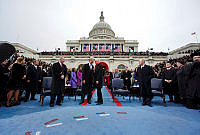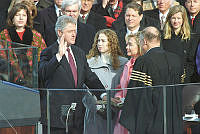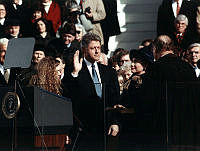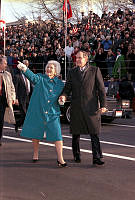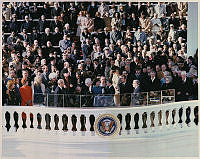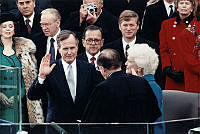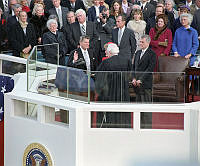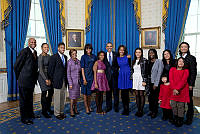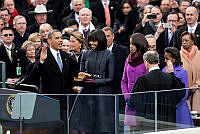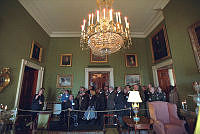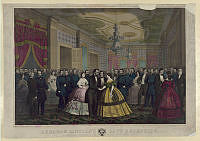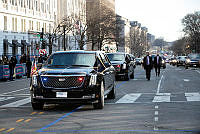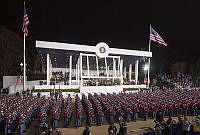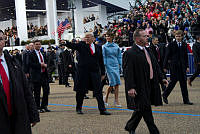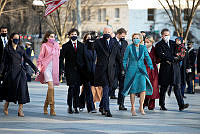Rubenstein Center Scholarship
Splendor and Scrutiny of White House Tableware

The Obama China Service was used for the Canadian State Dinner on March 10, 2016, with Prime Minster Justin Trudeau and his wife, Sophie Grégoire Trudeau.
White House Historical AssociationWhen Canadian Prime Minister Justin Trudeau and his wife Sophie Grégoire-Trudeau attended a State Dinner at the White House on March 10, 2016, they enjoyed a meal that was the result of months of thoughtful preparation. From the floral arrangements to the menu, no detail was overlooked—and this included the plates off of which they ate. Guests at White House functions have the opportunity to use the beautiful and sometimes controversial china that presidents and first ladies have purchased through the years, taking part in a tradition that began nearly 200 years ago.
Each administration has a unique approach to White House furnishings. Some presidents and first ladies oversaw major renovation and refurbishment projects, while others made only minor changes. Their tableware purchases have been guided by changing styles and trends, growing numbers of attendees at White House functions, and the need to replace chipped or broken china. Funding, too, has played a role, as the amount Congress has traditionally made available to a president for household expenditures has fluctuated considerably over time.
Circumstances change, but public awareness remains constant. Americans have long conceived of the White House as the “people’s house,” and take a keen interest in the furnishings and tableware that fill it. Visitors, collectors, journalists, and politicians have monitored and commented on the president’s tableware. Porcelain, as these stories remind us, can sometimes get political.
The first administrations made china purchases out of necessity. President John Adams and First Lady Abigail Adams became the first White House occupants in November 1800, and during their brief stay began to address the immense task of furnishing the large, empty house. Presidents Thomas Jefferson and James Madison continued these efforts, but early progress came to an abrupt halt in August 1814 when British troops entered the capital and set fire to the White House. It would fall to President James Monroe to refurnish the renovated executive mansion—and he did so with flair.1

As the first china purchased for official White House use, the Monroe service began a longstanding tradition. Many, though not all, administrations have taken part.
White House Historical AssociationMonroe made many elegant purchases, including a selection of gilded French furniture and decorative items that awed his visitors. In 1817 he also ordered the first state china service intended for official presidential use, initiating a tradition in which many later administrations would take part. 2 The Monroe service has a symbolic design, featuring an eagle and vignettes representing Strength, Agriculture, Commerce, Art, and Science along an amaranth-colored border.
Over a decade later, a tableware purchase again became necessary. Presidents had always entertained guests, but on March 4, 1829, the newly-inaugurated Andrew Jackson threw a party unlike any the White House had ever seen. Jackson’s inaugural reception attracted guests from as far as 500 miles away. Revelers filled the Executive Mansion, attempting to shake Jackson’s hand and offer their best wishes to the president who had been a candidate of the common people. As they lunged for refreshments, they broke furniture and china, upended trays of food, and spilled drinks on the carpet. To Jackson’s opponents, the mayhem signified the danger of an ungovernable rabble, a “mobocracy.” His supporters viewed it simply as a celebration that got out of hand, with no real harm done. 3 Shards of shattered china, however, suggested otherwise, and in 1831 Jackson ordered a full dinner service to replace the china that had been chipped and broken during the reception.

Though its purchase was controversial, the Lincoln china, with its purple or “Solferino” design, has become one of the most popular service sets and is still used for special occasions today.
White House Historical AssociationPresident Martin Van Buren would pay a political price for his predecessors’ purchases. When Van Buren entered office in 1837, the country was in the midst of an economic depression. Its effects did not seem to reach the White House, however, where Van Buren lived in a world of “pomp & gorgeous splendor,” according to one visitor.4 Indeed, Van Buren did live a fashionable and refined lifestyle, and used the $20,000 appropriation from Congress to refurbish some of the White House’s heavily used State Rooms.5 But when Van Buren requested a supplemental sum for additional purchases in 1840, he met with resistance.
Congressman Charles Ogle scrutinized the president’s expenditures and delivered his famous humorous but scathing account of Van Buren’s allegedly kingly trappings. He accused the president of splurging on French china and decorating the White House rooms as “glittering and dazzling saloons,” with a “magnificent and sumptuous array of gold and silver.”6 Of course, much of this splendor—including the infamous golden cutlery—could be attributed to Presidents Monroe and Jackson, but the speech did considerable damage. Van Buren lost the 1840 bitter election to Ogle’s candidate of choice, William Henry Harrison, a man touted as the “Log Cabin” candidate for his modest lifestyle.
Through the years first ladies have also come under public scrutiny, especially in times of economic and political turmoil. In 1861 First Lady Mary Todd Lincoln went shopping in New York City and ordered a new china service to supplement the White House’s depleted tableware supply.7 Though Mrs. Lincoln spent far less on furnishings than her successors—the Johnsons and Grants both received upwards of $100,000 in Congressional appropriations—at the time the purchase attracted criticism.8 As the country braced for war, the expense seemed frivolous.

The Reagan china was on display at a 1988 state dinner for President Moussa Traore of Mali. First Lady Nancy Reagan selected a service that featured her favorite color, red.
White House Collection/White House Historical AssociationThe pattern repeated itself. In the midst of the Great Depression, First Lady Eleanor Roosevelt’s announcement that she planned to order a 1,000-piece china service met with some disapproval.9 First Lady Nancy Reagan’s 1981 china purchase, which coincided with budget cuts, elicited a similar reaction, despite the fact that the funds for the service came from a private donation—indeed, since the 1960s, funds for china have come not from Congress but from donors and, more recently, from the White House Historical Association. President Ronald Reagan weighed in on the so-called “china crisis,” pointing out that the White House badly needed new tableware. “The truth of the matter,” he stated, “is at a state dinner, we can’t set the tables with dishes that match.”10 Even presidential porcelain, he insisted, was prone to chip and break.
At other times, china selections attracted praise. First Lady Caroline Harrison designed the pattern for the Harrison state china, incorporating corn stalks in reference to American agriculture. The design was well received, and her interest in china painting helped to make it a popular pastime.11First Lady Lady Bird Johnson’s china also had a personal touch. The service featured 40 varieties of wildflowers, a personal favorite of Mrs. Johnson, and 50 state flowers, capturing, in the first lady’s words, the “spirit of American unity by including each state in the service.” 12

The unique Hayes china service features artistic renderings of American flora and fauna.
White House Historical AssociationPerhaps the most acclaimed and controversial china was that of First Lady Lucy Hayes. In 1879 she commissioned artist Theodore R. Davis to design a unique service featuring American flora and fauna. Davis created 130 distinct designs, incorporating everything from apples and quail to lobster and buffalo. The Washington Post called it “the most original and beautiful set of porcelain ever made,” but that sentiment was not universally held.13 Years later, First Lady Helen Taft opted not to purchase new china, for she believed that the custom left the White House closets “loaded up with a mass of china most of which is hideous and ordinary… [the Hayes] china is too awful for words.”14
The tableware guests use at state dinners, then, was carefully selected for the event, but also specially chosen for use at the White House. Presidential china has a practical and aesthetic function, but also a rich and interesting past. Each plate, bowl, and saucer tells a story about presidents, first ladies, and the times in which they lived.

First Lady Michelle Obama inspects the “Kailua blue” pattern selected for the Obama service, April 23, 2015. The color was inspired by the waters that surround President Barack Obama’s home state of Hawaii.
Official White House Photo by Amanda Lucidon









